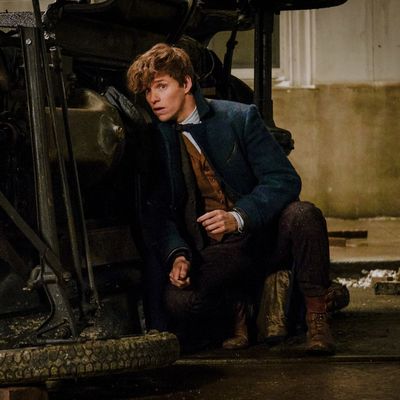
Few movies are as conceptually tedious as Fantastic Beasts and Where to Find Them, which transports J.K. Rowling’s fascist-wizards versus liberal-wizards-and-muggles conflict to 1920s New York — or a stagy, computer-generated simulation thereof. This time the script is by Dame J.K. herself, and from the outset — before we’ve even gotten to know the characters or the stakes — it’s hectic, cluttered, and ineptly staged. The Dickensian simplicity of the Harry Potter films has been replaced by a lot of desperate mugging. Part of the problem is that Rowling and her studio are not so much telling a story as erecting another “tentpole,” the Hollywood name for a “franchise” that becomes a virus — but is nonetheless regarded as a remedy for red ink. I only wish there were a vaccine.
From the start, Rowling tries to keep a lot of balls in the air, but gravity’s a bitch for a neophyte screenwriter. After an unseen monster ravages a block of tenements, an adorably tousled Eddie Redmayne, as someone called Scamander, steps off a ship from England with a battered brown suitcase full of odd creatures, one of which promptly escapes. (He’s not much of a zookeeper.) While Scamander is tracked by a bumbling member of the wizard police with the intriguing name Porpentina Goldstein (Katherine Waterston), he gets his suitcase mixed-up with an identical one belonging to a tubby little man called Kowalski (Dan Fogler) who dreams of opening a bakery.
All this mayhem is set against a background of fanaticism. On one side, a crusader named Mary Lou (Samantha Morton) — she recalls the ‘20s temperance activists — tries to rouse the rabble against supernatural forces she’s convinced are plaguing the city. On the other, there’s apparently a proto-Voldemort racial supremacist called Gellert Grindelwald on the loose, plotting in secret to dominate the muggle world. (In the U.S., the word is not “muggle” but the much less elegant “No-Maj.”) Colin Farrell plays the sleek, icy wizard who surveys the damage and enlists Mary Lou’s patently demented disciple (an even weirder than usual Ezra Miller) to help him track down a member of a new species: a kind of child wizard forced to repress his or her magical power. The result of said repression is that the child is consumed, but not before wreaking havoc on buildings and bystanders.
If you followed the above synopsis, good for you. If you didn’t, the bottom line is that Rowling has resurrected her one big Potter theme and introduced a new wrinkle. The repressive fascists are once more the villains, but the damage now goes deeper than imprisoning or murdering liberal opponents. As in many horror films, people (here, children) forced to muzzle their gifts go quietly crazy, the upshot being rampaging id-monsters and self-immolation. Trump-like xenophobes led by a mogul called Shaw (Jon Voight) might correctly see danger to America, but Rowling is pretty firmly on the side of the tolerant. For one thing, her male hero is a sweetie who seeks to protect all creatures great and small that both the wizard and human worlds would rather see exterminated. The wizards, fearful of exposure, are more muzzling than the muggles.
Redmayne looks great in his oversize overcoat, his hair flopped over and jutting about three inches from his forehead. He seems a bit simpleminded, though. I was more taken with Waterston’s giddy Goldstein, even if her long, expressive frame has been buried under a shapeless wardrobe of trousers and shirts. Her sister, Queenie (Alison Sudol), is more stereotypically girly, a woozy-eyed floozy with the ability to read minds, who takes a mysterious shine to Kowalski, having discerned his genuine passion for baked goods. It’s a borderline offensive role, but Sudol is a singer and gives her dumb lines a musical lilt. Her sweetness comes through.
The director, David Yates, did well with the last four Potter films (excepting The Deathly Hallows, Part 1, which was padded to squeeze another billion from the series), but here seems little more than a traffic cop who’s out of his depth. The script is partly at fault. On the Marvel films, for example, the studio brings in million-dollar streamliners and gagmen for last-minute rubbing and buffing, but who’d dare rewrite Rowling? I miss the Potter series’ screenwriter Steve Kloves, who’s here a credited producer. Maybe now that he has made his fortune, he can write and direct another movie as good as The Fabulous Baker Boys.
Those looking to find fantastic beasts from a movie called Fantastic Beasts and Where to Find Them might be disappointed. Apart from a small green twig creature that scampers around Scamander and an immense griffin that appears in the climax, they aren’t especially fantastic and the effects are too blandly corporate to be exhilarating. The movie might pass muster for kids weaned on the Harry Potter films — I shudder to think of the movies that pleased me when I was 7 or 8 — and uncritical critics. But you’d have to be desperate for another Potter fix to think this is magical entertainment. It’s thoroughly No-Maj.


